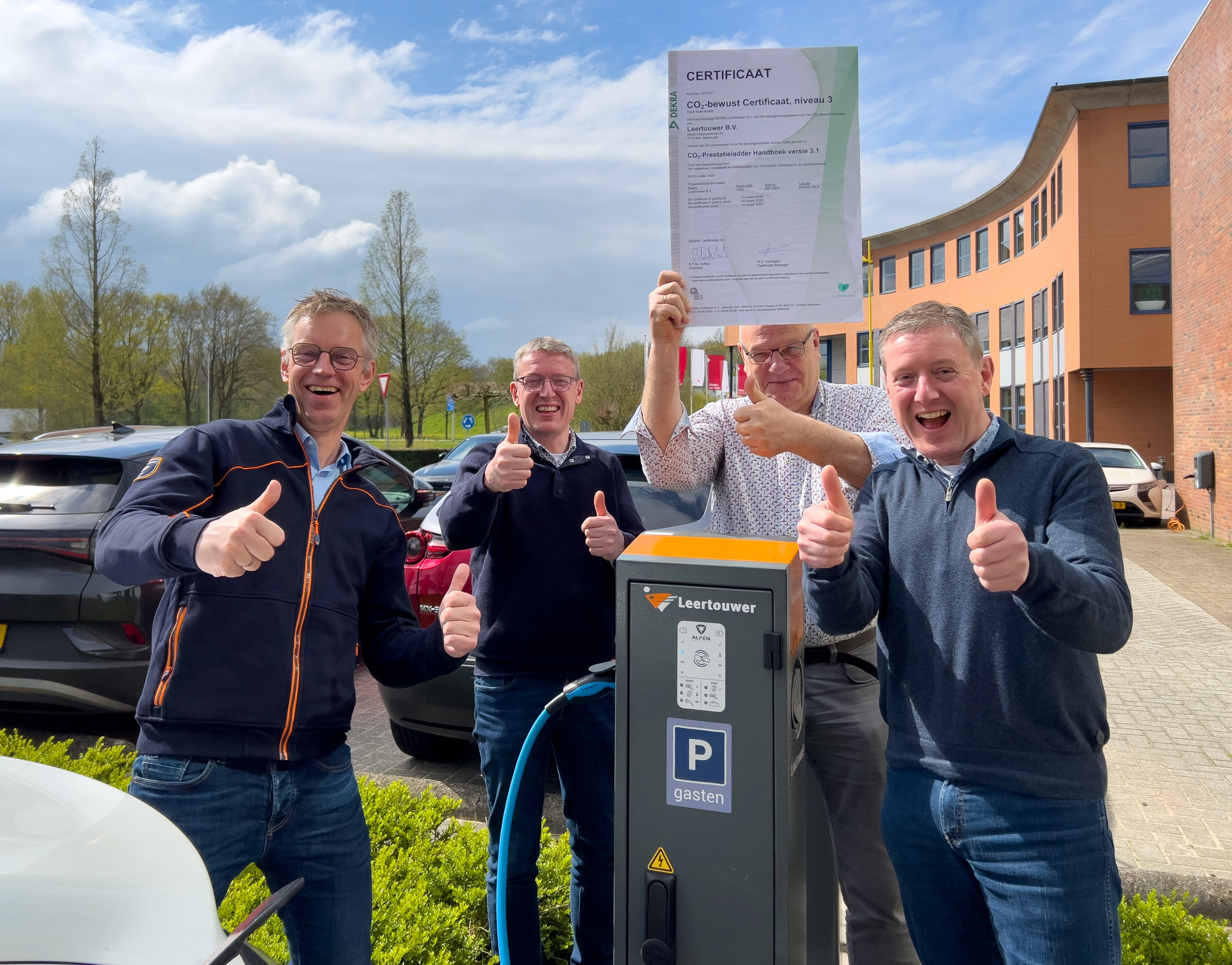
‘We have had solar panels on our roof for almost 25 years and do a lot in the field of sustainability,’ says Van der Boon. The family business has existed for almost 95 years and today is a renowned systems integrator in electrical engineering, climate installations and ICT. ‘Yet our sustainability efforts were nowhere to be seen. Our CO₂ Performance Ladder certificate shows at least how we score on CO₂ emissions. That is nice for us, but we also want to show our sustainability ambitions and performance very clearly to the outside world. In my experience, that still happens too little.’
Fleet
The aim of the CO₂ Performance Ladder is to create insight into your own emissions. Van der Boon: “For us, this is mainly in the energy consumption of our building and our vehicle fleet. We started by switching to electric transport. With about a hundred company cars, we didn’t manage that overnight, but we have made a start and we are growing steadily. Another example: when our central heating boiler needed replacing, we opted for a combination of gas and a heat pump. That reduces both our gas consumption and CO₂ emissions. Furthermore, we put extra solar panels on the roof with which we generate our own green energy for the heat pump.’
Four core values
Nieko Versteeg, marketing manager: ‘You can compare the CO₂-Performanceladder with ISO certification. It involves a certification process that concludes with obtaining a certificate. Sustainability really is one of our four core values. We had been working on it for a long time, both in terms of business operations and in the construction chain. The CO₂-Performanceladder gave us the opportunity to have those activities validated. The Ladder brings together many facets. It is practical and measurable and makes it very insightful for companies and governments we work for.’
In government tenders, the CO₂ Performance Ladder certificate provides benefits. Van der Boon explains: ‘The moment you tender, you get a notional discount. As a result, you tender at a lower price, so to speak. So that price component creates a different value in the tender. For public authorities, the CO₂ Performance Ladder is a nice tool, because it ensures that everyone is measured against the same yardstick. The sustainability performance of tendering companies can be seen at a glance. This makes it easy to include sustainability in the weighting and awarding of contracts.’
If more companies join this system, it will contribute to a sustainable future, Van der Boon believes. ‘For us, participation now certainly does not yet outweigh the costs of setting up and maintaining an improvement cycle. But my conviction is that you really have to want this as a company. And by the way: as a company, the tender discount compensates you a bit for the investments you make to reduce your CO₂ emissions.
Good examples
‘It is very difficult to bring about a behavioural change in people,’ says Versteeg. ‘With the CO₂-Performanceladder, we as a company are taking the lead and setting a good example, so to speak. We hope this will inspire our colleagues to also reduce CO₂ emissions themselves, privately. That would be a wonderful bonus. It’s about seemingly small things like checking tyre pressure. It saves fuel. And if you do that not only with your company bus, but also with your family car, that really adds up.’
Van der Boon adds, “You can see it reflected in legislation now: on the first of January 2024, the normative Work-Related Passenger Mobility regulation goes into effect (in the Netherlands). From then on, companies with more than a hundred employees will have to report annually to the Rijksdienst Voor Ondernemend Nederland (RVO) on the CO₂ emissions of business travel and commuting by employees. This includes, for example, the number of car kilometres travelled, broken down by fuel type. Because we have the CO₂ Performance Ladder, we already have insight into that, it takes us relatively little work to supply that data.’
Level 3
Leertouwer is now at level 3 and is very happy with it. Versteeg: ‘Level 3 relates to your own processes; things we can control ourselves. Levels 4 and 5 go a lot further, also involving processes in the chain. We do of course take certain follow-up steps, but it is not necessarily our ambition to climb the Ladder. The bigger you are as a company, the more impact you have. For us, level 3 is fine for now. It means that we have to report twice annually on what we are doing, and communicate transparently about our targets. Hence, we have included it on our website. We hope this will inspire other installers and supply chain partners. Our main goal now is primarily to reduce our own carbon emissions.
Greenwashing
Should certifications such as the CO₂ Performance Ladder be an obligation? Or is it more of a responsibility for companies individually? René van der Boon hesitates about an ‘obligation’, but does think it is a great tool, especially for the government, to gain insight into quality and sustainability. ‘I would also recommend it to other companies as well. If you really want to achieve something in terms of sustainability, this is a great tool. The audit made it clear to us how serious this label is; your company structure is also scrutinised; it is impossible to put away some diesel cars in a small private limited company, so to speak.’ Versteeg, laughing, “The term greenwashing disappears completely from your vocabulary.”
Written by Marion de Graaff for Bouw en Installatie Hub (Construction and Installation Hub)